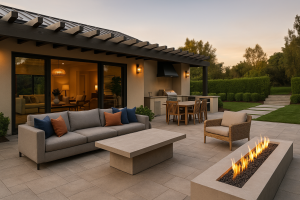When it comes to protecting your home from hail damage, choosing the right roof is crucial. Hail can cause significant and costly damage to a home’s roofing system, leading to leaks, structural damage, and a decrease in resale value. Therefore, homeowners should invest in hail-resistant roofing options that can withstand the impact of hailstones.
But what is the best type of roof for hail resistance? There are several roofing options available that can provide excellent hail resistance, and in this section, we will explore them in detail. We’ll highlight the factors that homeowners should consider when choosing a hail-resistant roof, discuss the impact resistance of various roofing materials, and provide information on asphalt shingles, metal roofs, clay and concrete tiles, synthetic roofing materials, and impact-resistant roofing systems for hail protection.
Factors to Consider for Hail-Resistant Roofs
Hail can cause significant damage to roofs, leading to expensive repairs or replacement. Therefore, it’s essential to consider several factors when choosing a hail-resistant roof.
1. Impact resistance rating
The impact resistance of a roof is crucial when it comes to hail resistance. It’s measured using a scale called the UL 2218 rating, which ranges from Class 1 to Class 4, with Class 4 being the most resistant to impact. A roof with a higher impact resistance rating can withstand larger hailstones without sustaining damage.
2. Material durability
The durability of the roofing material is another crucial factor to consider for hail resistance. Some materials, such as asphalt shingles, are more susceptible to hail damage than others like metal or tile. Therefore, it’s essential to choose a roofing material that is durable and can withstand the impact of hailstones.
3. Slope of the roof
The slope of the roof is also an important consideration for hail protection. A steep roof is less likely to sustain damage from hail than a flat or low-sloped roof. Hailstones can slide off a steeper roof more quickly, reducing the impact on the roof surface.
4. Roof design
The design of the roof can also impact its ability to resist hail damage. A complex roof design with many ridges and valleys can be more susceptible to damage than a simple design with a flat surface. Therefore, it’s essential to consider the roof design and choose an option that is more resistant to hail damage.
Impact Resistance of Roofing Materials
When considering a hail-resistant roof, it’s important to understand the impact resistance of different roofing materials. Some materials, such as asphalt shingles, may be more susceptible to damage from hail than others.
Metal roofing, for example, is known for its durability and resistance to impact. Unlike asphalt shingles, which can crack and break from hail impacts, metal roofs can often withstand even large hailstones without damage.
Clay and concrete tiles are also highly impact-resistant, thanks to their hard, thick composition. They may even be able to withstand direct hits from larger hailstones.
Synthetic roofing materials, such as synthetic slate or rubber, can also provide high levels of impact resistance. These materials are often designed specifically for their ability to withstand harsh weather conditions like hail.
When it comes to choosing a hail-resistant roofing material, it’s important to consider not only impact resistance, but also the material’s ability to protect against other weather-related damages, such as wind and water.
Asphalt Shingles as a Hail-Resistant Roofing Option
When it comes to hail-resistant roofing options, asphalt shingles are a popular choice due to their affordability and effectiveness.
Benefits of Asphalt Shingles
One of the biggest advantages of asphalt shingles is their durability. They are able to withstand harsh weather conditions, including hail storms, without sustaining significant damage. Additionally, asphalt shingles are easy to install and maintain.
Another benefit of asphalt shingles is their versatility. They come in a wide range of colors and styles, which allows homeowners to choose a shingle that complements their home’s aesthetic.
Effectiveness of Asphalt Shingles Against Hail Damage
Asphalt shingles are considered a good choice for hail-resistant roofing due to their impact resistance. They are able to absorb the force of hailstones without breaking or cracking. However, the level of impact resistance can vary depending on the quality of the shingles.
| Class | Impact Resistance |
|---|---|
| Class 1 | Resistance to 1.25-inch diameter hailstones |
| Class 2 | Resistance to 1.5-inch diameter hailstones |
| Class 3 | Resistance to 1.75-inch diameter hailstones |
| Class 4 | Resistance to 2-inch diameter hailstones |
It is important to note that not all asphalt shingles are created equal. It is recommended to choose shingles that are rated Class 3 or above to ensure optimal hail resistance.
Installation and Maintenance of Asphalt Shingles
Proper installation and maintenance of asphalt shingles is essential for their longevity and hail resistance. It is important to hire a professional roofing contractor who has experience with installing asphalt shingles to ensure proper installation. Additionally, regular maintenance, such as cleaning gutters and checking for damage, can help prolong the life of the shingles and maintain their effectiveness against hail damage.
Metal Roofs for Hail Resistance
Metal roofs have become increasingly popular due to their durability, longevity, and energy-efficient properties. They are also a great option for hail resistance.
Metal roofs are made from materials such as aluminum, steel, copper, or zinc. These materials have a high resistance to impact and can withstand the force of hailstones without sustaining significant damage.
Advantages of Metal Roofs for Hail Resistance
Metal roofs offer several advantages when it comes to hail resistance:
- High impact resistance: The metal material used in the construction of metal roofs is incredibly tough and can resist the force of hailstones effectively.
- Durable: Metal roofs are extremely durable and can last for several decades, making them a cost-effective option in the long run.
- Low maintenance: Metal roofs require minimal maintenance and can be easily cleaned with a hose or power washer.
- Energy-efficient: Metal roofs reflect the sun’s rays and prevent heat absorption, reducing the need for air conditioning and saving on energy bills.
Types of Metal Roofs for Hail Resistance
There are several types of metal roofs available that offer hail resistance:
| Type | Pros |
|---|---|
| Standing seam metal roofs | Interlocking panels provide increased durability and resistance to hail damage. They also have concealed fasteners, preventing water leakage. |
| Corrugated metal roofs | Lightweight and cost-effective, these roofs have ribs that provide structural support and impact resistance. They are also easy to install. |
| Stone-coated metal roofs | Have the appearance of traditional roofing materials, such as slate or clay tiles, while offering the strength and durability of metal. The stone coating provides additional insulation and hail resistance. |
If you are considering a metal roof for your home or business, it is essential to consult with a professional roofing contractor to discuss your options and ensure proper installation for maximum hail resistance.
Clay and Concrete Tiles for Hail Protection
Clay and concrete tiles are popular roofing materials known for their durability and longevity. They are also excellent at providing protection against hail damage. In fact, clay and concrete tiles have been shown to withstand hailstones as large as 3 inches in diameter.
One of the key advantages of clay and concrete tiles is their weight and density. Compared to other roofing materials, they have a higher mass per unit of area. This means they are less likely to be damaged by hail impacts. Additionally, they have a low thermal conductivity, which helps to reduce energy costs by keeping the home cooler in hot weather.
| Pros | Cons |
|---|---|
| Durable and long-lasting | Heavy weight may require additional roof support |
| Excellent hail protection | Higher initial cost compared to some other roofing materials |
| Low thermal conductivity | May break or crack if stepped on |
It is important to note that proper installation is critical for maximizing the hail resistance of clay and concrete tiles. This includes using a proper underlayment and ensuring adequate roof support. It is also recommended to have regular inspections and maintenance to address any potential issues.
If you are considering clay or concrete tiles for your hail-resistant roof, be sure to consult with a professional roofing contractor to determine if they are the right choice for your home and climate.
Synthetic Roofing Materials for Hail Resistance
In recent years, synthetic roofing materials have become increasingly popular for their durability, aesthetic appeal, and hail resistance. Made from plastic or rubber composites, synthetic roofing materials offer superior protection against hail damage.
Benefits of Synthetic Roofing Materials
Synthetic roofing materials offer numerous benefits, including:
- Increased hail resistance
- Lightweight and easy to install
- Fire-resistant
- Low-maintenance
- Long-lasting
- Recyclable
Additionally, synthetic roofing materials come in a variety of colors and styles, allowing homeowners to achieve the look they desire.
Types of Synthetic Roofing Materials
Some popular synthetic roofing materials for hail resistance include:
| Roofing Material | Description |
|---|---|
| Synthetic Slate | Made from rubber or plastic, synthetic slate mimics the look of natural slate while providing superior hail resistance. |
| Rubber | Rubber roofing is made from recycled materials and offers excellent resistance to impact and hail damage. |
| Thermoplastic Olefin (TPO) | TPO is a type of rubber roofing that is popular for commercial buildings due to its energy efficiency and hail resistance. |
Drawbacks of Synthetic Roofing Materials
While synthetic roofing materials offer many benefits, they do have some drawbacks to consider.
- Higher cost compared to traditional roofing materials
- Not as environmentally friendly as some natural roofing materials
- May not be as aesthetically appealing to some homeowners
It is important to weigh the benefits and drawbacks of synthetic roofing materials to determine if they are the right choice for your home.
Impact-Resistant Roofing Systems
Impact-resistant roofing systems can provide an added layer of protection for your home against hail damage. These systems are designed to absorb the impact of hailstones, preventing them from damaging the roofing materials underneath. Here are some of the common impact-resistant roofing systems available:
Layered Systems
A layered roofing system consists of multiple layers of roofing materials, such as asphalt shingles or tiles, with a layer of cushioning material in between. The cushioning layer can be made of various materials, such as rubber, foam, or fiberglass, and is designed to absorb the impact of hailstones. This type of roofing system provides excellent protection against hail damage and can also improve the energy efficiency of your home by providing extra insulation.
Reinforced Options
Reinforced roofing materials, such as polymer-modified shingles or metal roofing with a high gauge, are specifically designed to be more durable and impact-resistant. Polymer-modified shingles have a layer of polymer material added to them, which makes them more flexible and better able to withstand impacts. Metal roofing with a high gauge is thicker and more durable than standard metal roofing, providing better protection against hail damage.
It is important to note that impact-resistant roofing systems are generally more expensive than standard roofing materials. However, the added protection and durability they provide can save you money in the long run by reducing the need for repairs or replacement due to hail damage.
Maintenance and Inspection of Hail-Resistant Roofs
Maintaining and inspecting your hail-resistant roof is crucial to ensure its continued effectiveness. Here are some essential tips you should keep in mind:
- Clean your roof regularly: Leaves, debris, and other elements can accumulate on your roof and hinder its ability to protect against hail. Make sure to clean your roof periodically to keep it in top shape.
- Inspect your roof after every hailstorm: Even if your roof is hail-resistant, it’s still important to check for any damage after a storm. Look for dents, cracks, or missing shingles. If you notice any damage, promptly contact a professional for repairs.
- Trim nearby trees: Overhanging branches can scratch or damage your roof during a hailstorm. Make sure to trim any tree branches that are too close to your roof.
- Check your gutters: Gutters can easily get clogged with debris, preventing rainwater from flowing properly. Check and clean your gutters regularly to avoid water damage to your roof and your home’s foundation.
- Hire a professional for inspections: While you can perform basic inspections yourself, it’s always best to hire a qualified professional to thoroughly evaluate your roof. They can identify any damage or potential hazards that you might miss.
Professional Installation for Hail-Resistant Roofs
Proper installation is crucial when it comes to ensuring the hail resistance of your roof. While some homeowners may attempt to install their roofing themselves, it is highly recommended to hire a professional roofing contractor instead.
Professional roofers have the knowledge, training, and experience necessary to properly install roofing materials, ensuring that they are applied correctly and securely. They are also aware of local building codes and regulations that must be followed when installing a roof.
When hiring a professional roofing contractor, it is important to choose a company with a solid reputation and ample experience in hail-resistant roofing. A reputable contractor should also be able to provide references and a warranty for their work.
Additionally, it is important to ensure that the roofing contractor is properly licensed and insured. This will protect you in the event of any accidents or damage that may occur during the installation process.
Overall, hiring a professional roofing contractor for the installation of your hail-resistant roof is a wise investment that will ensure the longevity and effectiveness of your roof for years to come.
FAQ: Common Questions about Hail-Resistant Roofs
Q: How can I tell if my roof has hail damage?
If you suspect that your roof has been damaged by hail, it is important to have it inspected by a professional. They will look for signs such as cracked, dented, or missing shingles, as well as damage to gutters and downspouts. However, it can be difficult to spot damage from the ground level alone, so it’s best to have a trained eye assess the situation.
Q: Can any type of roof be hail-resistant?
No, not all roofs are created equal when it comes to hail resistance. Some materials, such as metal and synthetic roofing, are better equipped to withstand hail damage than others. Additionally, roofing systems that are specifically designed to be impact-resistant offer even greater protection.
Q: Will a hail-resistant roof cost more than a regular roof?
While a hail-resistant roof may come with a higher upfront cost, the investment can pay off in the long run with potentially lower repair or replacement expenses after a hailstorm. Additionally, some insurance companies offer discounts for homes with hail-resistant roofing, which can help offset the initial cost.
Q: Can I install a hail-resistant roof myself?
It is not recommended to install a hail-resistant roof yourself unless you have the necessary training and experience. Improper installation can compromise the effectiveness of the roofing materials and potentially put your home at risk during a hailstorm. It is best to hire a professional contractor who is experienced in the installation of hail-resistant roofing systems.
Q: How often should I have my hail-resistant roof inspected?
It is recommended to have your hail-resistant roof inspected annually, especially after a severe weather event. Regular inspections can identify potential issues before they become major problems and help maintain the roof’s hail resistance.
Q: Will a hail-resistant roof protect my entire home from hail damage?
While a hail-resistant roof can provide significant protection against hail damage, it does not guarantee complete protection for the rest of your home. Other areas, such as windows, siding, and outdoor structures, may still be vulnerable to hail damage. It is important to take a comprehensive approach to protecting your home during severe weather events.








